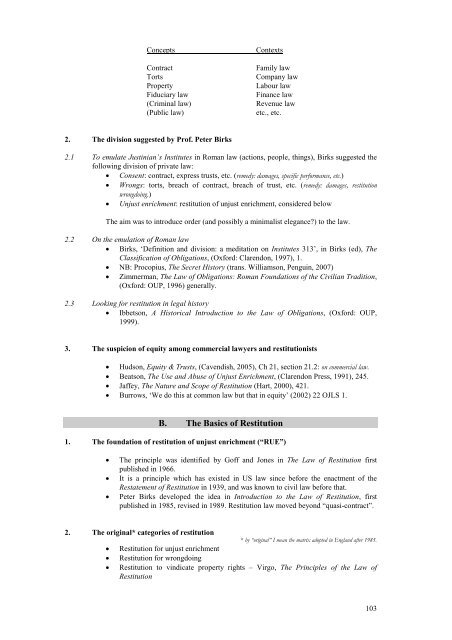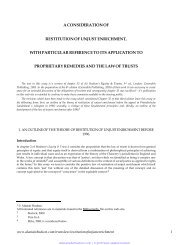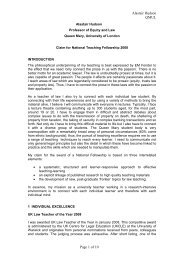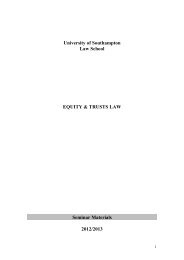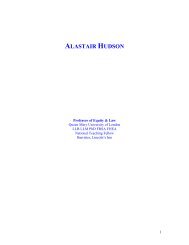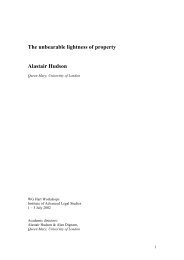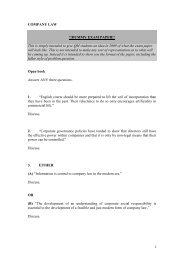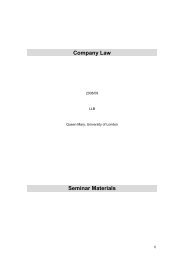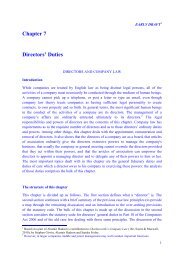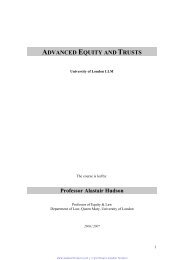Soton Equity and Trusts - alastairhudson.com
Soton Equity and Trusts - alastairhudson.com
Soton Equity and Trusts - alastairhudson.com
You also want an ePaper? Increase the reach of your titles
YUMPU automatically turns print PDFs into web optimized ePapers that Google loves.
Concepts<br />
Contract<br />
Torts<br />
Property<br />
Fiduciary law<br />
(Criminal law)<br />
(Public law)<br />
Contexts<br />
Family law<br />
Company law<br />
Labour law<br />
Finance law<br />
Revenue law<br />
etc., etc.<br />
2. The division suggested by Prof. Peter Birks<br />
2.1 To emulate Justinian’s Institutes in Roman law (actions, people, things), Birks suggested the<br />
following division of private law:<br />
Consent: contract, express trusts, etc. (remedy: damages, specific performance, etc.)<br />
Wrongs: torts, breach of contract, breach of trust, etc. (remedy: damages, restitution<br />
wrongdoing.)<br />
Unjust enrichment: restitution of unjust enrichment, considered below<br />
The aim was to introduce order (<strong>and</strong> possibly a minimalist elegance?) to the law.<br />
2.2 On the emulation of Roman law<br />
Birks, ‘Definition <strong>and</strong> division: a meditation on Institutes 313’, in Birks (ed), The<br />
Classification of Obligations, (Oxford: Clarendon, 1997), 1.<br />
NB: Procopius, The Secret History (trans. Williamson, Penguin, 2007)<br />
Zimmerman, The Law of Obligations: Roman Foundations of the Civilian Tradition,<br />
(Oxford: OUP, 1996) generally.<br />
2.3 Looking for restitution in legal history<br />
Ibbetson, A Historical Introduction to the Law of Obligations, (Oxford: OUP,<br />
1999).<br />
3. The suspicion of equity among <strong>com</strong>mercial lawyers <strong>and</strong> restitutionists<br />
Hudson, <strong>Equity</strong> & <strong>Trusts</strong>, (Cavendish, 2005), Ch 21, section 21.2: on <strong>com</strong>mercial law.<br />
Beatson, The Use <strong>and</strong> Abuse of Unjust Enrichment, (Clarendon Press, 1991), 245.<br />
Jaffey, The Nature <strong>and</strong> Scope of Restitution (Hart, 2000), 421.<br />
Burrows, ‘We do this at <strong>com</strong>mon law but that in equity’ (2002) 22 OJLS 1.<br />
B. The Basics of Restitution<br />
1. The foundation of restitution of unjust enrichment (“RUE”)<br />
<br />
<br />
<br />
The principle was identified by Goff <strong>and</strong> Jones in The Law of Restitution first<br />
published in 1966.<br />
It is a principle which has existed in US law since before the enactment of the<br />
Restatement of Restitution in 1939, <strong>and</strong> was known to civil law before that.<br />
Peter Birks developed the idea in Introduction to the Law of Restitution, first<br />
published in 1985, revised in 1989. Restitution law moved beyond “quasi-contract”.<br />
2. The original* categories of restitution<br />
* by “original” I mean the matrix adopted in Engl<strong>and</strong> after 1985.<br />
Restitution for unjust enrichment<br />
Restitution for wrongdoing<br />
Restitution to vindicate property rights – Virgo, The Principles of the Law of<br />
Restitution<br />
103


